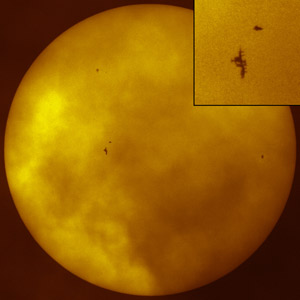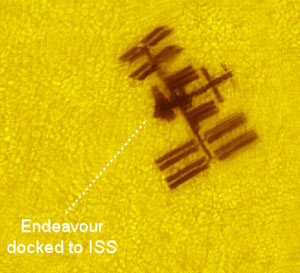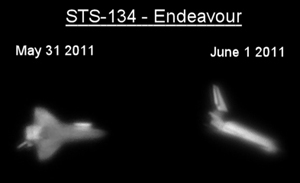Thierry Legault is a wonder. His astrophotos and shots of orbiting satellites have graced this blog many, many times (see Related Posts below), but even so I get a thrill every time he sends me a note about new pictures. Wanna know why? Check this out: Endeavour docked on the International Space Station:
Holy. Haleakala! [Click to embiggen; note that the images shown here are also done with Emmanuel Rietsch.]
This may be the most amazing shot of an Orbiter and ISS I have ever seen! Oh… and did I mention this was taken from the ground? Yegads.
 The detail is incredible; you can see features on Endeavour, the open payload bay doors, and all sorts of accoutrements on the station itself (including the newly-installed the Alpha Magnetic Spectrometer-2). This picture actually shows three frames from a video; as the ISS and Orbiter pass overhead their angle to the ground changes, and you can see that in the sequence. The video itself is embedded on his website, and you have to see it to believe it. He has 3D versions, too!
The detail is incredible; you can see features on Endeavour, the open payload bay doors, and all sorts of accoutrements on the station itself (including the newly-installed the Alpha Magnetic Spectrometer-2). This picture actually shows three frames from a video; as the ISS and Orbiter pass overhead their angle to the ground changes, and you can see that in the sequence. The video itself is embedded on his website, and you have to see it to believe it. He has 3D versions, too!
And there’s more. As Endeavour was on approach to dock with ISS he got this amazing shot of it silhouetted against the Sun (click to see it in full-res, and yes, you really really want to). The time window for getting a picture with the Orbiter and ISS like this is just a matter of hours; it’s hard enough figuring out where and when on Earth to see the Orbiter against the Sun, but to happen to nail it when it’s only a hundred meters from the ISS is mind-boggling. I love how the clouds add a bit of drama to the scene, too. It doesn’t hurt that several sunspots are dotting the disk of the Sun, too. The space station looks odd, but you’re seeing it from the side, so it’s more edge-on.
This next one may give you more of a sense of scale here:
 This shot, taken a few days earlier, shows Endeavour still docked to the ISS. You can see it more clearly in the zoom here; again, the detail is amazing. The pair were about 500 km (300 miles) from the camera when this shot was taken. The entire transit – the time it took for the spacecraft to cross the face of the Sun – was only about a half second!
This shot, taken a few days earlier, shows Endeavour still docked to the ISS. You can see it more clearly in the zoom here; again, the detail is amazing. The pair were about 500 km (300 miles) from the camera when this shot was taken. The entire transit – the time it took for the spacecraft to cross the face of the Sun – was only about a half second!
Incidentally, the weird speckly appearance of the Sun’s surface in that picture is real: those are convection cells, enormous regions where hot plasma from inside the Sun rises, cools, and sinks back down into the interior. These are technically called granules, and can be well over 1000 km across. Of course, they’re on the Sun which is several hundred thousand times farther away than the space station. That makes them look a wee bit smaller.
 And finally, I love this picture: I sometimes call the Orbiter a “space plane”, but shots like this really (pardon the pun) bring it home. In the picture on the right (taken just minutes before Endeavour made its last de-orbit burn to return to Earth) you can even see the dark vertical line on the Orbiter’s tail fin! I think the dark horizontal line just below it is the shadow of the wing on the fuselage; the level of detail is just low enough to make that hard to discern. It might be the foreshortened black underside of the wing.
And finally, I love this picture: I sometimes call the Orbiter a “space plane”, but shots like this really (pardon the pun) bring it home. In the picture on the right (taken just minutes before Endeavour made its last de-orbit burn to return to Earth) you can even see the dark vertical line on the Orbiter’s tail fin! I think the dark horizontal line just below it is the shadow of the wing on the fuselage; the level of detail is just low enough to make that hard to discern. It might be the foreshortened black underside of the wing.
Thierry and Emmanuel use excellent equipment, but still. Yikes. Taking pictures like these take a lot of planning and traveling (Thierry told me he went to Germany, France, and Spain to get these shots), and the experience needed really shines through. These pictures are phenomenal.
It’s too bad there’s only one more Shuttle space shot left; I wonder what Thierry and others like him will do for that mission. I know there will always be interesting hardware up there in orbit to photograph, so I hope that even after the Sun sets on the Shuttle missions there will still be amazing pictures coming from the astrophotography community.
Image credits: Thierry Legault and Emmanuel Rietsch. Used with permission.
Related posts:
- Discovery spacewalk seen from the ground!
- INSANELY awesome solar eclipse picture!
- ISS, Shuttle transit the Sun
- EXTREMELY cool 3D Space Station video – taken from the ground!
- When natural and artificial moons align